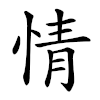情
| ||||||||
Translingual
| Traditional | 情 |
|---|---|
| Simplified | 情 |
| Japanese | 情 |
| Korean | 情 |
| Stroke order (Mainland China) | |||
|---|---|---|---|
 | |||
| Stroke order (Taiwan) | |||
|---|---|---|---|
 | |||
| Stroke order (Mainland China) | |||
|---|---|---|---|
 | |||
Alternative forms
- In mainland China, Hong Kong (based on its educational standard), Japanese kanji and Vietnamese Hán Nôm, the bottom right component is written ⺝ with a vertical 丨 left stroke.
- In Taiwan, the bottom right component is written 月 with a curved 丿 left stroke.
- In Korean hanja, the bottom right component is written 円 which is the historical form found in the Kangxi Dictionary.
Han character
情 (Kangxi radical 61, 心+8, 11 strokes, cangjie input 心手一月 (PQMB), four-corner 95027, composition ⿰忄青(GHTJV) or ⿰忄靑(K))
Derived characters
- 𫠽
References
- KangXi: page 389, character 31
- Dai Kanwa Jiten: character 10756
- Dae Jaweon: page 723, character 17
- Hanyu Da Zidian (first edition): volume 4, page 2312, character 13
- Unihan data for U+60C5
Chinese
| trad. | 情 | |
|---|---|---|
| simp. # | 情 | |
| 2nd round simp. | 𰑊 | |
| alternative forms | 啨 𢚏 ⿰忄𤯞 ⿰十青 | |
Glyph origin
| Old Chinese | |
|---|---|
| 猜 | *sʰlɯː |
| 輤 | *sʰleːns |
| 綪 | *sʰleːns, *ʔsreːŋ |
| 倩 | *sʰleːns, *sʰleŋs |
| 棈 | *sʰleːns |
| 蒨 | *sʰeːns |
| 篟 | *sʰeːns |
| 生 | *sʰleːŋ, *sreŋs |
| 牲 | *sreŋ |
| 笙 | *sreŋ |
| 甥 | *sreŋ |
| 鉎 | *sreŋ, *sleːŋ |
| 珄 | *sreŋ |
| 鼪 | *sreŋ, *sreŋs |
| 猩 | *sreŋ, *seːŋ |
| 狌 | *sreŋ |
| 眚 | *sreŋʔ |
| 貹 | *sreŋs |
| 崝 | *zreːŋ |
| 精 | *ʔsleŋ, *ʔsleŋs |
| 菁 | *ʔsleŋ |
| 鶄 | *ʔsleŋ, *sʰleːŋ |
| 蜻 | *ʔsleŋ, *sʰleːŋ |
| 鼱 | *ʔsleŋ |
| 婧 | *ʔsleŋ, *zleŋs, *zleŋʔ |
| 睛 | *ʔsleŋ, *sʰleŋʔ |
| 箐 | *ʔsleŋ |
| 聙 | *ʔsleŋ |
| 旌 | *ʔsleŋ |
| 清 | *sʰleŋ |
| 圊 | *sʰleŋ |
| 請 | *sʰleŋʔ, *zleŋs, *zleŋ |
| 凊 | *sʰleŋs |
| 䝼 | *zleŋs, *zleŋ |
| 靚 | *zleŋs |
| 情 | *zleŋ |
| 晴 | *zleŋ |
| 夝 | *zleŋ |
| 靜 | *zleŋʔ |
| 靖 | *zleŋʔ |
| 睲 | *seŋʔ, *seːŋs |
| 惺 | *seŋʔ, *seːŋ |
| 性 | *sleŋs |
| 姓 | *sleŋs |
| 靗 | *l̥ʰeŋs |
| 鯖 | *ʔljeŋ, *sʰleːŋ |
| 青 | *sʰleːŋ |
| 靘 | *sʰleːŋ, *sʰleːŋs |
| 掅 | *sʰleːŋs |
| 胜 | *sleːŋ |
| 曐 | *sleːŋ |
| 星 | *sleːŋ |
| 鮏 | *sleːŋ |
| 腥 | *seːŋ, *seːŋs |
| 鯹 | *seːŋ |
| 醒 | *seːŋ, *seːŋʔ, *seːŋs |
| 篂 | *seːŋ |
Phono-semantic compound (形聲, OC *zleŋ) : semantic 心 (“heart”) + phonetic 青 (OC *sʰleːŋ).
Etymology
Its meaning "feeling" prompts Benedict (1976) to connect it to Proto-Sino-Tibetan *s-niŋ (“heart; brain; mind”); while its other meaning "proper nature, situation" suggests cognacy to 生 (shēng, “to live, life”) (Boltz, 1976), though the initials of 情 (OC *dzeŋ) vs. 生 (OC *srêŋ) are difficult to reconcile (Schuessler, 2007) – not withstanding Zhengzhang (2003)'s reconstructions 情 (OC *zleŋ) vs. 生 (OC *sʰleːŋ).
Pronunciation
Definitions
情
Compounds
|
|
|
Descendants
Japanese
| Shinjitai | 情 | |
| Kyūjitai [1] |
情󠄁 情+ 󠄁?(Adobe-Japan1) |
 |
| 情󠄃 情+ 󠄃?(Hanyo-Denshi) (Moji_Joho) | ||
| The displayed kanji may be different from the image due to your environment. See here for details. | ||
Readings
Compounds
- 風情 (fuzei, “taste; elegance; appearance”)
Derived terms
- 情感 (jōkan): emotion
- 情事 (jōji): love affair
- 情勢 (jōsei): situation
- 情報 (jōhō): information
- 情熱 (jōnetsu): enthusiasm
- 愛情 (aijō): love
- 詩情 (shijō): poetic sentiment
- 事情 (jijō): state of affairs
- 実情 (jitsujō): real condition; actual circumstances
- 非情 (hijō): heartlessness
- 表情 (hyōjō): facial expression
- 風情 (fūjō): appearance; outward attitude
- 熱情 (netsujō): passion
- 友情 (yūjō): friendship
- 旅情 (ryojō): travel weariness
References
- “情”, in 漢字ぺディア (Kanjipedia) (in Japanese), 日本漢字能力検定協会, 2015—2023
- 2006, 大辞林 (Daijirin), Third Edition (in Japanese), Tōkyō: Sanseidō, →ISBN
Korean
Compounds
- 감정 (感情, gamjeong, “emotion”)
- 격정 (激情, gyeokjeong, “passion”)
- 동정 (同情, dongjeong, “sympathy”)
- 무정 (無情, mujeong, “emotionless”)
- 민정 (民情, minjeong, “state of the common people's lives”)
- 발정 (發情, baljeong, “oestrus; rut”)
- 색정 (色情, saekjeong, “sexual urge; sexual desire; lust”)
- 서정 (抒情, seojeong, “lyricism”)
- 실정 (實情, siljeong, “the real situation”)
- 심정 (心情, simjeong, “feeling”)
- 애정 (愛情, aejeong, “love”)
- 역정 (逆情, yeokjeong, “anger; rage”)
- 정가 (情歌, jeongga, “love song”)
- 정경 (情景, jeonggyeong, “sad scene”)
- 정보 (情報, jeongbo, “information”)
- 정색 (情色, jeongsaek, “erotica”)
- 정취 (情趣, jeongchwi, “artistic mood; touch”)
- 정황 (情況, jeonghwang, “circumstances; conditions”)
- 풍정 (風情, pungjeong, “elegance”)
Vietnamese
Han character
情: Hán Việt readings: tình[1][2][3][4][5]
情: Nôm readings: tành[1][2][3][6][4][5][7], tình[1][2][4][7], dềnh[1][3][6], rình[1][3], thanh[1], xênh[1], tạnh[3]
Compounds
- 情歌 (tình ca)
- 情況 (tình huống)
- 情願 (tình nguyện)
- 情狀 (tình trạng)
- 愛情 (ái tình)
- 風情 (phong tình)
- 色情 (sắc tình)
- 情報 (tình báo)
- 抒情 (trữ tình)
References
- Nguyễn (2014).
- Nguyễn et al. (2009).
- Trần (2004).
- Bonet (1899).
- Génibrel (1898).
- Hồ (1976).
- Taberd & Pigneau de Béhaine (1838).